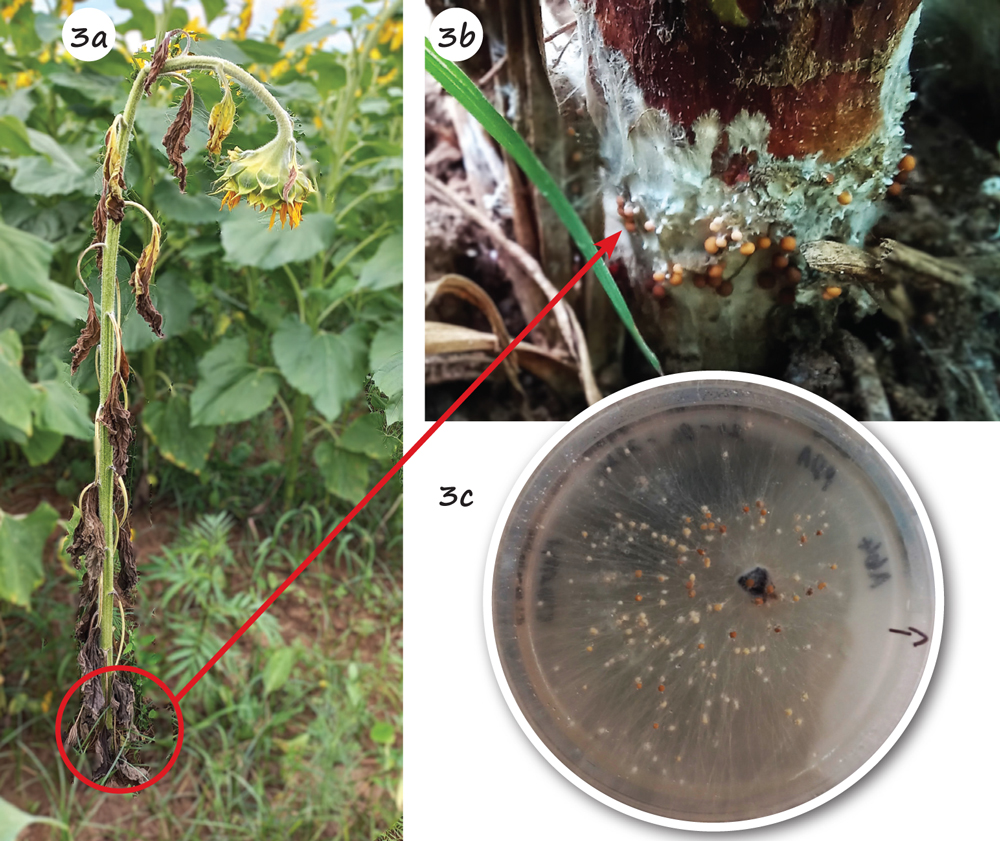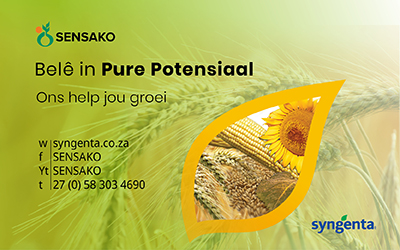
Free State

Dr Lisa Rothmann, Department Plant Sciences, Plant Patho-logy, University of the Free State
Disease surveillance is critical to early disease detection for timely reporting and appropriate decision-making. Annually, the sunflower and soybean national cultivar trials (NCTs) are planted, maintained, harvested, and evaluated by the Agricultural Research Council-Grain Crops (ARC-GC) across multiple localities. In partnership with the ARC-GC and affiliated seed companies, the University of the Free State’s epidemiology and field pathology team surveyed for diseases at the NCT sites.
Surveys allow for confirming the prevalence of existing diseases and increasing vigilance for emergent diseases. A total of 33 sites across both crops, with different cultivars in six provinces, were surveyed and diagnosed on the characteristic symptomology of diseases and the associated disease causal organism in morphology and microscopy. Molecular confirmation of pathogens is underway where symptoms were not easily distinguished. The team reports on the incidence and prevalence of the diseases observed, where incidence refers to the number of plants per location presenting specific disease symptoms. In contrast, prevalence refers to the localities at which each disease was observed. Although some localities had high incidences, the severity was seldom yield limiting.
In the sunflower survey, verticillium wilt (known to be caused by Verticillium dahliae, an ascomycetous fungus) was the most prevalent disease at all localities surveyed. This soilborne pathogen infects the stem and spreads throughout the plant, limiting yield by blocking xylem cells (Harverson et al., 2016), resulting in necrosis and chlorosis between the leaf veins (Photo 1). Lesions dry out and reduce the photosynthetic active area on the leaf surface. Symptoms will first occur on the bottom leaves and progress, causing premature wilting in severe cases. Microsclerotia remain dormant in the soil for up to 14 years, with no host plant required (Wilhelm, 1955). The most sustainable management practice is to identify tolerant cultivars.

Alternaria leaf blight (commonly caused by Alternaria spp., chiefly Alternaria helianthi [Kgatle, 2018]), occurred in 55% of the localities surveyed, and the incidence ranged from 2% to 100%. Symptoms usually appear as dark brown lesions on the lower leaves, stems, petiole, and head (Photo 2). Severe infections reduce photosynthetic efficiency and lead to early leaf drop, impacting overall plant vigour. The variability in disease incidence across sites suggests differences in environmental conditions and cultivar susceptibility. Effective management includes selecting resistant cultivars and applying appropriate fungicides, especially in high-risk environments.

Southern blight (caused by Sclerotium rolfsii) is a basidiomycetous fungal pathogen observed at 22% of the sites surveyed, with a range of 2% to 25% incidence. Southern blight poses a significant threat by limiting individual plant yield due to basal rot, presenting as thread-like white mycelium growth, resulting in complete plant death. Light brown spherical fruiting bodies are found among the white mycelium up to the taproot (Photo 3). In contrast, Sclerotinia sclerotiorum basal rot is associated with a cottony white mycelium and black irregular-shaped sclerotia.

The most prevalent diseases observed in soybean were Cercospora leaf spot, bacterial blight, Septoria brown spot, and Phyllosticta leaf spot. Sclerotinia stem rot (Photo 4) and root-knot nematodes (Photo 5) were observed at two localities. They were considered yield-limiting at these sites, even though they only appeared in 4% of the locations this year.


Cercospora leaf spot (caused by Cercospora kikuchii, a fungal pathogen) was observed at 95% of locations with 4% to 80% incidences, indicating environmental and cultivar interactions in disease development. The disease affects the photosynthetic function of leaves, turning the upper surface of the leaf into a bronze-purple colour and leathery texture (Photo 6). The symptoms can be mistaken for sunburn. Sunburn occurs mainly on the downside of a soybean leaf as the leaf curls when exposed to heat stress, whereas the disease showcases its symptoms on the upper leaf surface.


Bacterial blight (known to be caused by Pseudomonas savastanoi pv. Glycinea) is reported as widespread in South Africa by the ARC (Meudi & Fourie, 2014). During the survey, the team observed symptoms of bacterial blight in 91% of localities, supporting the statement above. In North America, bacterial blight is not considered a significant threat to soybean yield (Meuller et al., 2016), similar to local observations where symptoms were not yield limiting. Soybeans are susceptible at all growth stages, showing symptoms in the middle to upper canopy. The disease results in small, angular, burn-like lesions with a yellow halo (Photo 7). Lesions may coalesce, and tissue disintegrates as the disease progresses. Bacterial blight can overwinter in seeds and plant debris (Meuller et al., 2016). It is essential to distinguish between bacterial blight and Septoria as their symptoms may look similar.

Septoria brown spot (with a fungal causative agent, i.e., Septoria glycines) is more prevalent in dense canopies and older leaves, with dark brown circular lesions, often with yellow borders (Photo 8). High soil moisture increases the incidence, accelerating leaf defoliation. Septoria can cause yield losses ranging from 2,5% to 9% (Cruz et al., 2010). However, the past season’s Septoria severities were very low and did not pose a threat to yield.

The disease management strategies below won’t necessarily increase input costs; they are all about preparation and planning. Considerations include the following:
- Crop rotation, especially with grasses, as sunflower and soybeans are broadleaf crops.
- Weed management is crucial because many weeds can serve as susceptible hosts for the previously mentioned diseases and favour the microclimate in the field, thereby contributing to the spread and reproduction of inoculum.
- Certified seed ensures the season is started with pathogen-free material to hinder infestation of the pathogen in disease-free fields.
- Regular scouting for diseases and pathogen signs in the field is essential for timely chemical applications when needed.
The team plans to conduct a survey in the coming season and include a diagnostic pipeline for the diseases observed to have causal organisms confirmed more rapidly. Producers are welcome to reach out for visual diagnostics. However, it is strongly recommended that pathogens be confirmed at one of the following disease clinics:
FABI Diagnostic Clinic: https://www.fabinet.up.ac.za/index.php/special-projects/diagnostic-clinic
Plant Health and Protection – ARC: https://www.arc.agric.za/arc-ppri/Pages/ARC-PPRI-Homepage.aspx
Stellenbosch University Disease Clinic: https://www.sun.ac.za/english/faculty/agri/plant-pathology/disease-clinic
The disease survey was made possible with the support and contributions of the following organisations and individuals: funders: Department of Science and Innovation, Technology Transfer and Innovation, OPDT and Grain SA; co-workers: Annelie de Beer, Lizette Bronkhorst, Heila Vermeulen, Dr Safiah Ma’ali and William Makgoga (ARC-GC), Louis Schoonraad (Corteva), Jobert Swanepoel (Agricol), Ben Pienaar (Agricol) and Dandre van Niekerk (Agricol). The two handbooks primarily used for symptom identifications were: A farmer’s guide to soybean diseases (American Phytopathological Society) and Compendium of sunflower diseases and pests (APS).
References
- Cruz, CD, Mills, D, Paul, PA & Dorrance, AE. 2010. Impact of brown spot caused by Septoria glycines on soybean in Ohio. Plant disease, 94(7), 820 – 826.
- Harverson, RM, Markell, SG, Block, CC & Gulya, TJ. 2016. Compendium of sunflower diseases and pests. The American Phytopathological Society.
- Meudi, H & Fourie, D. 2014. Bacterial diseases of dry beans: Every producer’s nightmare. ARC-Grain Crop Institute.
- Meuller, D, Wise, K, Sinnon, A, Smith, D, Sikora, E, Bradley, C & Robertson, A. 2016. A farmer’s guide to soybean diseases. The American Phytopathological Society.
- Wilhelm, S. 1955. Longevity of the Verticillium wilt fungus in the laboratory and field.





























